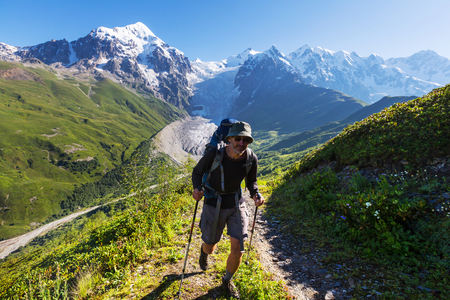1. Building a Culture of Stewardship on the Trails
The Roots of Respect: Leave No Trace Across America
Across the United States, hikers are more than just visitors on a trail—they’re caretakers of wild spaces. From the crisp pine air of the Rockies to the misty ridges of the Appalachians, an everyday ethos is taking hold: leave no trace. This principle isn’t just about picking up trash; it’s about respecting every inch of soil, every call of a bird, and every delicate wildflower along the path. Hikers young and old are learning to plan ahead, stick to established trails, and minimize their impact so that everyone can enjoy these landscapes for generations.
Volunteerism: Hands-On Trail Love
The American hiking community is rolling up its sleeves. Volunteer days have become as much a part of hiking culture as sturdy boots and weathered backpacks. Local clubs, national parks, and grassroots organizations organize everything from trail cleanups to invasive species removal. These gatherings turn strangers into teammates and give hikers a stake in the health of their favorite places.
Popular Volunteer Initiatives by Region
| Region | Common Initiatives | Key Organizations |
|---|---|---|
| Rocky Mountains | Trail restoration, wildfire recovery | Colorado Fourteeners Initiative, Volunteers for Outdoor Colorado |
| Pacific Northwest | Invasive species pulls, trail maintenance | Washington Trails Association, Pacific Crest Trail Association |
| Appalachians | Shelter repairs, litter pickups | Appalachian Trail Conservancy, Potomac Appalachian Trail Club |
| Southeast | Biodiversity monitoring, waterway cleanups | Southeastern Foot Trails Coalition, Friends of the Smokies |
Grassroots Initiatives: Locals Leading by Example
The most powerful changes often start with neighbors. All across America, small groups are making big impacts—organizing guided nature walks that teach kids about native plants, starting “adopt-a-trail” programs where hikers pledge to care for a mile of path, or launching social media campaigns encouraging others to respect wildlife habitats. Many of these projects are homegrown solutions tailored to each region’s unique challenges.
How You Can Get Involved:
- Join a local trail club or nonprofit group.
- Participate in monthly cleanup events or restoration days.
- Share your experiences online to inspire friends and family.
- Teach others about Leave No Trace principles during your hikes.
- Support legislation that protects public lands and wilderness areas.
This movement isn’t about perfection—it’s about progress. Every hiker who picks up a stray granola wrapper or helps repair a footbridge becomes part of a larger story: one where stewardship is second nature and our wild places remain vibrant for all who come after us.
2. Trail Organizations: The Backbone of Advocacy
A Visual Journey Through the Heart of Trail Stewardship
Step into the wild, and you’ll find more than just breathtaking views—you’ll discover a dedicated network of trail organizations and nonprofits working tirelessly behind the scenes. These groups are the unsung heroes of America’s hiking culture, shaping how we protect our landscapes for future generations. Their efforts blend conservation policy, habitat restoration, and hands-on education, creating an enduring impact across the country.
Key Players in Conservation Policy
From the Pacific Crest Trail Association in the West to the Appalachian Trail Conservancy in the East, major trail associations play a pivotal role in advocating for public lands. They work with lawmakers, rally volunteers, and partner with local communities to keep trails open and wild spaces protected. By joining forces with government agencies like the National Park Service and U.S. Forest Service, these organizations ensure that hikers’ voices are heard at every level.
| Organization | Main Focus | Region | Notable Achievements |
|---|---|---|---|
| Pacific Crest Trail Association (PCTA) | Trail protection & stewardship | West Coast (CA, OR, WA) | Secured federal protection for PCT corridors |
| Appalachian Trail Conservancy (ATC) | Land preservation & advocacy | East Coast (GA-ME) | Coordinated corridor-wide habitat restoration projects |
| American Hiking Society | National policy & grassroots mobilization | Nationwide | Pushed for National Trails System Act amendments |
Restoring Habitats—One Step at a Time
Beyond policy work, these organizations put boots on the ground for habitat restoration. Volunteers remove invasive species, repair eroded paths, and plant native trees—all essential for healthy ecosystems. These efforts not only preserve scenic beauty but also support wildlife that depend on unspoiled habitats along America’s most iconic trails.
An Example from the Field:
- The Ice Age Trail Alliance in Wisconsin has restored thousands of acres of native prairie along the trail corridor, offering a haven for pollinators like monarch butterflies.
- The Colorado Trail Foundation leads annual “adopt-a-trail” days where locals work side by side to rebuild sections damaged by storms or heavy use.
Cultivating Future Stewards Through Education
The next generation of environmental advocates starts here: trail organizations offer youth programs, outdoor classrooms, and interpretive hikes designed to foster a lifelong love for nature. By connecting people—especially young hikers—to their local trails, these nonprofits build a deeper understanding of conservation’s importance.
- PCTA’s “Trail Skills College”: Free workshops teach volunteers skills from basic trail maintenance to advanced wilderness first aid.
- ATC’s “Trail to Every Classroom”: A program that empowers teachers to integrate outdoor learning into their curriculum across states bordering the Appalachian Trail.
The Ongoing Impact: Community-Led Advocacy
This visual journey through America’s hiking community reveals how interconnected we are with our landscapes—and how much is possible when passionate people come together. As you lace up your boots for your next adventure, remember: every step supports a movement led by these vital organizations guiding us toward a greener tomorrow.
![]()
3. Harnessing Technology for Environmental Impact
The Digital Trail: How Hikers are Going High-Tech
From the misty forests of the Pacific Northwest to the sun-soaked canyons of Utah, hikers across the U.S. are embracing technology as a powerful tool for environmental advocacy. With smartphones tucked into backpacks and social media at their fingertips, today’s outdoor lovers are finding new ways to protect and celebrate America’s wild places.
Apps: More Than Just Maps
Trail apps like AllTrails, Gaia GPS, and iNaturalist have become digital companions for millions. These platforms do more than just help hikers find their way—they also allow users to report trail damage, invasive species, or litter hotspots directly to park managers or volunteer groups. Many apps now include built-in features that encourage users to log wildlife sightings, track rare plant locations, and share notes on Leave No Trace practices.
| App Name | Main Purpose | Environmental Advocacy Feature |
|---|---|---|
| AllTrails | Trail navigation & reviews | User reports on trail conditions & cleanups |
| iNaturalist | Wildlife & plant identification | Crowdsourcing biodiversity data for scientists |
| Litterati | Litter tracking & removal | Documenting and mapping cleanup efforts by location |
| Gaia GPS | Advanced route planning | Custom markers for environmental hazards or restoration sites |
#TrailStewardship: The Power of Social Media Campaigns
Instagram, Facebook, and TikTok are not just platforms for sharing stunning summit selfies. Hikers use these channels to organize group cleanups, launch awareness campaigns like #LeaveNoTrace or #PackItOut, and spotlight both the beauty and vulnerability of public lands. Short videos demonstrating how to pick up micro-trash or properly dispose of waste have gone viral, inspiring thousands to join in stewardship efforts—sometimes even from afar.
How Social Media Inspires Action:
- Awareness: Visual posts highlight problems like overcrowding or vandalism.
- Community Building: Online groups coordinate real-world meetups and trail work days.
- Advocacy: Viral hashtags amplify petitions or fundraising drives for conservation projects.
Crowdsourcing Solutions: Reporting Trail Issues in Real Time
The hiking community is now a critical early-warning system for America’s trails. Using apps and dedicated hotlines, hikers can quickly flag fallen trees, washed-out bridges, graffiti, or illegal dumping. This instant feedback loop helps land managers respond faster than ever before—and gives volunteers the info they need to prioritize repairs or restoration efforts.
Sample Trail Issue Reporting Workflow:
- A hiker spots erosion damage during a weekend trek.
- The hiker snaps a photo and uploads it via an app with location data.
- The report is sent to local rangers and volunteer crews within minutes.
- A repair team mobilizes based on up-to-date information.
Together Toward a Greener Future
The U.S. hiking community’s embrace of technology is shaping a new era of environmental advocacy—one where every hiker can make an impact with just a few taps. As these digital tools continue to evolve, so too does the community’s ability to protect the wild places that inspire us all.
4. Amplifying Underrepresented Voices in the Outdoor Movement
Building a More Inclusive Trail Community
The future of environmental advocacy in the U.S. hiking community is being shaped by efforts to bring more voices to the table. For decades, the classic image of a hiker has often been one-dimensional, but America’s trails stretch across a diverse landscape and touch communities of all backgrounds. Today, many organizations and grassroots groups are working hard to ensure that everyone feels welcome on the trails and has a say in how these precious places are protected.
Key Initiatives Making an Impact
Here’s a look at some standout programs helping to empower underrepresented communities:
| Initiative | Who It Empowers | Main Focus |
|---|---|---|
| Outdoor Afro | Black Americans | Connecting Black communities with nature through hikes, education, and leadership development |
| Latino Outdoors | Latinx Communities | Creating cultural connections and encouraging Latinx participation in outdoor recreation and conservation |
| Indigenous Women Hike | Native Americans, especially women | Reclaiming ancestral lands through hiking while sharing Indigenous knowledge and perspectives |
| Unlikely Hikers | LGBTQ+, plus-size, disabled, BIPOC hikers | Cultivating an inclusive hiking culture by challenging stereotypes about who belongs outdoors |
Why Representation Matters on the Trail
When more people see themselves reflected in trail leadership and outdoor stories, it sparks greater participation and a stronger sense of belonging. Representation helps shape policies that are fairer and more effective because they draw from a wider range of experiences. This means better protection for local environments—and more creative ways to connect people with nature.
The Ripple Effect: Advocacy That Mirrors America
The movement toward inclusivity isn’t just about numbers—it’s about making sure that future environmental advocacy truly reflects the American landscape in all its diversity. By empowering different voices, the hiking community ensures that stewardship decisions are made with respect for every corner of our country, from city parks to remote mountain trails. As these initiatives grow, so does our collective ability to protect the places we love for generations to come.
5. Policy, Protection, and the Power of Collective Action
How Hikers Turn Passion into Policy
If you’ve ever stood at a trailhead in the U.S., surrounded by towering pines and sweeping vistas, you know that hiking is more than just a pastime—it’s a way of life for millions. But what happens when these outdoor lovers band together to shape the future of America’s wild spaces? Across the country, hikers are channeling their passion into real change, pushing for policies that protect public lands and address climate issues.
The Trail from Trails to Legislation
It starts with a love for the outdoors, but quickly moves into action. Hikers write letters to Congress, attend town halls, and join groups like the American Hiking Society or local trail coalitions. These efforts add up—turning everyday adventurers into advocates who help shape laws that keep trails open and wild places safe.
Key Areas Where Hikers Make an Impact
| Policy Focus | How Hikers Get Involved | Impact on Wild Spaces |
|---|---|---|
| Public Lands Protection | Signing petitions, participating in public comment periods, joining advocacy events | Preserves access to national parks, forests, and wilderness areas |
| Climate Policy | Lobbying for clean energy bills, supporting climate marches, educating others about climate impacts on trails | Helps slow environmental changes threatening trails and ecosystems |
| Trail Funding & Maintenance | Volunteering for trail work days, fundraising for trail organizations, supporting “Rails-to-Trails” initiatives | Keeps trails safe, accessible, and well-maintained for everyone |
| Wildlife Conservation | Supporting wildlife corridors, promoting Leave No Trace principles, reporting illegal activity on trails | Protects native species and keeps ecosystems healthy |
The Ripple Effect: Why Collective Action Matters
No single hiker can do it alone. But when thousands raise their voices—whether it’s sending postcards to senators or showing up for trail cleanup—the message is loud and clear: Americans care deeply about their wild places. This collective action pushes lawmakers to prioritize conservation funding and smart land management, shaping not just today’s trails but those for generations to come.
A Future Built Together
The path ahead isn’t always easy. Climate change brings new challenges; budgets shift; new threats emerge. But with every step taken by hikers who speak out and show up, the future of America’s mountains, forests, deserts, and coastlines grows brighter—and wilder. The story of U.S. hiking is still being written, one policy win (and one muddy boot print) at a time.
6. Visions for Tomorrow: Youth, Education, and the Next Generation
The Trail Begins with Young Hikers
Across the United States, the hiking community is actively planting seeds for the future by empowering young people to become stewards of the land. Programs that invite youth into the outdoors are more than just weekend adventures—they are launching pads for lifelong connections to nature and environmental advocacy. From local after-school groups to national initiatives, these efforts aim to instill a sense of responsibility and wonder in the next generation.
Programs Bridging Youth and Nature
| Program Name | Focus Area | Key Activities | Impact |
|---|---|---|---|
| Outdoor Afro Youth Leadership | Diversity & Inclusion | Guided hikes, leadership workshops, conservation projects | Empowers Black youth to lead in outdoor spaces |
| Sierra Club’s Inspiring Connections Outdoors (ICO) | Urban Access | Nature outings, environmental education, skill-building trips | Makes nature accessible to underserved youth in cities |
| Leave No Trace Youth Program | Environmental Ethics | Workshops on sustainability, trail clean-ups, outreach events | Promotes responsible recreation habits early on |
| American Hiking Society’s NextGen Trail Leaders | Youth Advocacy | Policy training, storytelling, advocacy campaigns | Cultivates young voices in policy and conservation work |
Storytelling: The Heartbeat of Advocacy
The power of sharing personal stories is central to engaging youth in environmental causes. When young hikers recount their first summit at sunrise or cleaning up a littered trail with friends, these memories become part of a larger narrative—one that celebrates discovery, resilience, and collective action. Social media platforms like Instagram and TikTok have given teens new ways to share their journeys, sparking interest among peers and inspiring others to get involved.
Paving the Way for Environmental Leadership
Education programs don’t just teach navigation skills or plant identification—they foster critical thinking about our relationship with wild spaces. By learning about native plants, wildlife habitats, and climate impacts firsthand, young people begin to see themselves as caretakers of these environments. Many organizations now offer mentorship opportunities where experienced hikers guide youth through both trails and advocacy efforts.
A Look Ahead: The Ripple Effect of Youth Engagement
The energy and creativity of today’s youth are shaping the future direction of America’s hiking movement. As more programs emerge connecting kids from all backgrounds with the outdoors, they are laying down strong roots for tomorrow’s leaders. With every hike taken and story told, the vision for a more inclusive and environmentally conscious hiking community grows clearer—ensuring that the voices of this next generation will echo across mountains and valleys for decades to come.


